1-2-2
 | 1 This is a conventional 1-2-2 zone, a match-up progression can be added. - Basics - Trapping - Early ballside coverage. See Defences - 32 match-up, Foster 3-2, Gamecocks 3-2, Pistons 1-2-2 match-up, Auburn 1-2-2, 10 zone, 1-2-2 match-up situations, also sliding 3-2 zones Tubby Smith, Jack Bennett, Raptors. 1) Basics X1 picks up the ball, the zone has a 1-2-2 shape. On a pass to 2, X2 closes out, X1 drops to cover the high post. X2 would bump X1 if 1 dribbles to the wing (it can be an aggressive jump switch). Brad Underwood, Tim Jancovich - X2, X1 or X3 pick up the ball in their third of the floor. Tubby Smith - fan 1 to the sideline, out of the middle, keep him on one side. Chris Oliver - a wing covers a skip pass, a post covers the next pass if it goes lower. Coach Mac 3-2 - put X1 on a wing and a long, athletic player that can finish at the top. X1-X2-X3 are in great position to fast break. X4 would take a skip pass to 4. Pistons - against a two-guard front, X1 takes the attacker on the left, forces sideline. Hoop Tactics 1-2-2 - the point defender guards the ball out front and defends the high-post area when the ball is on the wings or in the corner. A tall athletic player can be very effective, with the point guard moving to a wing. The wings are at the elbows, X4 and X5 are above the blocks. |
 | 2 X4 fronts the low post or plays low outside, he has to get out to the corner on a pass to 4. X5 is the help on a lob pass. X3 would take a skip pass to 3. Tubby Smith - X4 plays outside low-post 5, butt to the baseline, guarding 5 with his inside hand. X5 is on the midline, butt to the baseline. Wings try to take any skip pass. Coach Mac - X4 must get front position on 5 to defend the pass to the corner, X5 should be playing in the middle of the lane, ready for a lob pass. If the ball is skipped to the opposite corner, X3 would close out then get bumped up by X5, or they trap. Hoop Tactics - wing X2 is on ball, X1 drops to ballside elbow, X3 drops into the middle, X4 is half way to the corner and X5 is in front of the basket. The wings work opposite. Foster 3-2 - X5 is ballside to help on low post 5, X4 plays outside. |
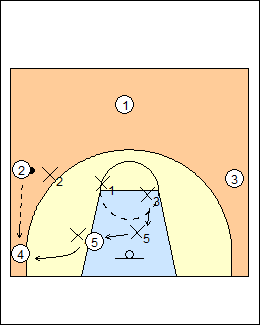 | 3 On a pass to the corner, X4 closes out, X5 comes across to cover the low post, X3 sinks to protect weakside. X2 can - bump X1 from the elbow - stay to deny a return pass to 2 (shown) - double-team the corner - drop to help on the low post or dribble penetration. Option - X1 can slide down to help defend the low post, X2 or X3 covers the high post. Oliver - when his partner X4 goes out, X5 comes across, and plays behind a low post. Coach Mac - X2 can sag in to prevent an inside pass, hard deny the wing, or trap the corner. Pistons 1-2-2 - one defender on the ball, four close to the paint. Jim Foster - X2 can deny (facing the ball), plug (gap), or trap. X5 fronts the low post. Brad Underwood - X5 plays behind the post. |
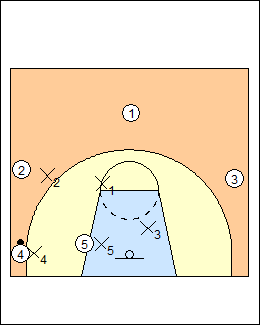 | 4 X5 covers the low post. X1 would take a skip pass to 1 and X3 take a skip pass to 3. Coach Mac - X4 takes away the baseline, X5 defends low post 5 but doesn't front. Option - on a post entry to 5, X1 and X5 can double-team (Bennett 3-2), or X4 and X5 (Gamecocks 3-2, Foster 3-2, Auburn 1-2-2). Hoop Tactics - X4 is on the ball, X5 covers the low-post area, X3 drops to weakside baseline, X2 cuts off a pass out of the corner or drops down to help low-post defender X5, X1 defends the high post area. X4 and X5 work in unison, as if tied together.  |
 | 2) Trapping Trapping situations include - losing late in a game - when a match-up catches the ball - to keep the ball out of the corners. The defence can trap the wings and/or corners (or short corners). Here X2 follows a pass to trap with X4, X5 covers the low post. X1 looks to intercept a pass to the wing but first covers the high post. X3 protects weakside but can look for steals. Tubby Smith - trap when the ball goes below a wing (e.g. to the short corner), X2 follows the pass. Boeheim - the corner trap is key to keeping the ball out of the corner. Brendan Suhr - run a 3-2 zone and trap the star whenever he catches the ball (see Chaser defence). Coach Mac - trapping at the top of the key is a great trap if you need a quick steal. X1 directs the ball to one side, the ballside wing defender sprints up to trap, the ballside post sprints high to take away a pass to the wing. |
 | 6 Red option (e.g. losing late in a game) - X1 rotates to take away sideline, X3 covers the high post area, leaving open a skip pass to 3. X5 can take away the low post (front from the top) if ballside when 2 has the ball (see Early ballside coverage). Boeheim - X1 covers the passing lane back to the wing, X3 covers any high post attacker or the point guard, X5 always fronts a low post. Coach Mac - always trap the corners, the top defender slides across to deny a pass back out, X5 half fronts 5, X3 tries to get a deflection or steal from 1 or 3. This is the best 1-2-2 trap. Hoop Tactics - the 1-2-2 zone can readily trap a pass to the corner. Wing X2 follows the pass and traps with X4, X1 steps out and cuts off a return pass to the wing, while X3 steps up and defends the high-post area anticipating a pass. Dave Smart - attack blitz a player who is not comfortable with the ball, shoot gaps to deny; control blitz a Kyrie Irving to make him pass, don't shoot gaps. See Foster 3-2. |
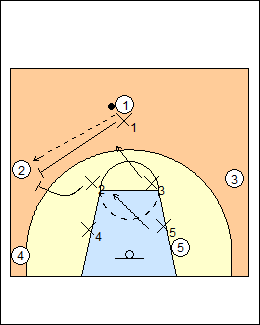 | 7 Here X1 follows a pass to 2 and traps with X2. The obvious pass is back to 1, optionally X3 covers that, X5 covers the high post (shown). Less aggressively, X3 covers the high post and return pass, X5 stays low as the goalie. Jim Larranaga ("thumbs down") - X3 rotates up top as reversal interceptor (RI), X5 moves up as high-post interceptor (HPI), X4 is the goaltender (GT). Tar Heels scramble - X3 covers the obvious pass back to 1, then backs off a bit because he may need to help on the high post. X5 is the goaltender, and stays low. Dean Smith - if 1 gets the ball right back from 2, they will go double him. St. Joseph 1-2-2 - "3" is a normal 1-2-2 zone, "31" applies a trap on the first pass when the ball is passed below the free-throw line extended. Herb Brown - 2T 3-2 zone - trap the first pass to the wing or corner. On the pass to 2, X3 zones up the middle and does not deny a pass back to 1, X5 is the goaltender. If 1 passes to 4, X2 and X4 trap and X5 would front a low post. Coach Mac - a trap on the wing should be used as a surprise on rare occasions. He finds it works best on a pass out of the corner. Trapping the first pass (or first penetrating pass) is an option in a halfcourt man or zone press. See Defences - Tar Heels scramble, George Mason scramble, 1-2-2 halfcourt press, also 2-3 Tubby Smith. |
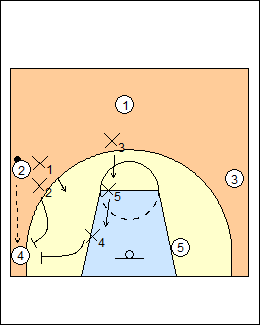 | 8 Trap again on a pass to the corner, X2 traps with X4. X1 stays to take away the sideline, X5 drops to cover the low post, X3 drops to cover the high post (a "red" trap, leaving open a skip pass). Blue option (less risky) - X1 bumps X3 and covers the elbow, X3 covers weakside.. Tar Heels - they like to double-team again on a short pass to the corner. X5 fronts the post, X3 drops back as goaltender, but can fly around, and may take 5 if he comes into the high post. The 1-2-2 can be used to defend sideline or baseline inbounds plays, see Defences - Tubby Smith 3-2, and Tar Heels scramble for sideline options (e.g. "both"). Hoop Tactics - X - set up a 1-2-2 zone, trap when the ball is inbounded from a backcourt sideline, can go trap again on the next pass.  |
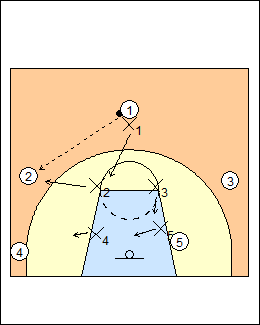 | 3) Early ballside coverage By default weakside post X5 comes across when the ballside post X4 goes out on the ball. Optionally have X5 come ballside if there is no attacker in his area of the zone, e.g. if the offence has a) Ballside low post and corner filled (an attacker below the ball) b) Ballside high post, corner filled c) Ballside high post, low post. X5 could also come across to help on a ballside low post, see Foster 3-2. Otherwise X5 can stay weakside for rebounding position (shown). NBA teams use hybrid man-zones that flood ballside and leave two weakside defenders covering three guys. Option - the weakside post always comes ballside (between the ball and basket), see Auburn 1-2-2, 10 zone (also Paul Hewitt point zone). Auburn - X5 is ballside, in line with the ball and the basket. X4 is halfway to the corner, parallel to the baseline, ready to deflect a pass to the low post with his inside arm. 10 zone - X4 fronts 5, X5 slides over to protect the middle. Match-up progression - each defender guards an attacker, see Defence - 1-2-2 match-up situations. The weakside post comes ballside if his match-up is ballside e.g. at the low post or high post, or to help on a ballside low post. X1 can take the high post if there is an overload. Box out your match-up on a shot, close out on a pass to your match-up. |
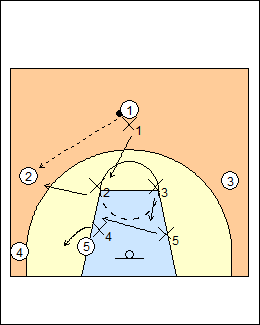 | a) Low post, corner filled A common tactic against a 1-2-2 zone is to fill the ballside low post and corner, X4 has to defend the low post, get out to the corner on a pass, and not get pinned in by 5. For early coverage, on the pass to 2, X4 goes over 5, X5 comes across to replace X4, X3 drops to protect weakside. Pistons - X4 goes over 5. |
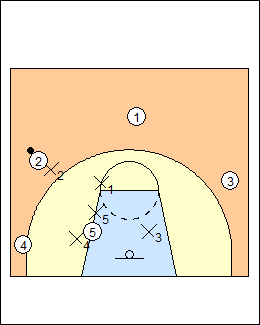 | 11 X4 could deflect a pass to the low post with his right hand, X5 is between the ball and the basket, and can slide in front of 5 (or behind) on a pass to the corner. 10 zone - if 2 passes to 4, X5 drops behind the post and gets help from X2 who drops down. Pistons - X2 takes the ball, X4 has 4, X1 has 1, X3 has 3, X5 has 5. X4 does not rush out on 4. On a pass to 4, X2 would sag to the elbow area, bumping X1. See 1-2-2 match-up situations - Duke runner (low post). |
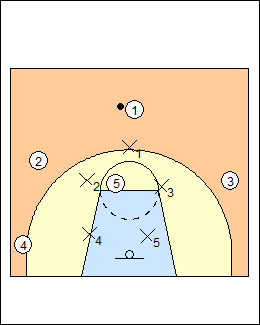 | b) High post, corner filled By default, X2 and X3 pinch the elbows to protect the high post when X1 is on the ball, then X1 drops to cover the high post on first pass, so it should be a short drop if there is a high post. X4 and X5 do not come up to guard the high post unless there is a pass there. Here X5 has no attacker in his area of the zone, but stays low until 5 gets a pass, or gets a pass and faces up. X1 can choke, dig or trap on a pass to 5. Optionally X2 and X3 can dig if 5 puts the ball on the floor. Foster 3-2 - X1 does not extend beyond the top of the key to help prevent a high-post pass. Raptors 3-2 - X1-X2-X3 keep the ball out of the high post. X1 does not over-extend to pick up the ball, and can instead just sink to cover the high post area against a high overload or two high posts. Coach Mac - the wings pinch in to protect the high post when the ball is at the top of the key. Getting the ball into the high post is what hurts a 1-2-2 zone the most. On a pass to 5, bring up X4 or X5 to guard the ball, he likes to designate which player. The top defender can dig, the wings must not pinch in. Variation - X5 comes up to guard 5 when X1 is on the ball. Pistons - X4 and X5 are on a buddy system. However, when there is a big at the high post, defenders stay matched up. X5 defends 5 at the high post. If the offence uses a 1-4 high set, bring up both low defenders. Tubby Smith - play inside-out, starting at the elbows. If 5 flashes to the high post when X1 is covering the ball, X5 comes up too, he has to find somebody to guard. X1 would pinch or trap on a pass to the high post. |
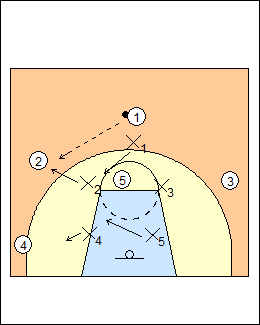 | 13 |
 | 14 X4 closes out on a pass to the corner, 5 dives (the low post is open), X5 is in position to guard it. Option - X1 can slide down as 5 dives, contesting a pass. Paul Hewitt point zone - X1 is playing above high post 5 with his right foot on the arc, defending 5 with his left hand, making the attackers think a pass is there. X5 is between the ball and the basket, but has his eye on 5. See 1-2-2 matchup situations - Duke runner (high post), also 2-1-2. |
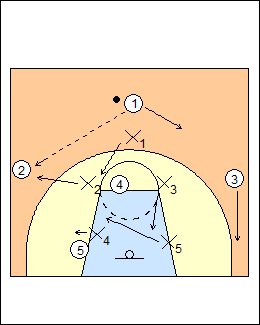 | c) High post, low post On a pass to 2, X1 covers the high post, X5 can come ballside. X5 could stay weakside since the high post and low post are covered, with no corner attacker, but coming ballside puts X5 in position to guard 4 diving if 2 makes a pass to 5 in the short corner, or on a high-post entry pass. Oliver - the high post is covered by the weakside low defender. They don't deny it and don't mind if it goes in there for a challenged 15-footer. They don't pressure the high post if he is not a shooter. X5 comes with 4 on a post flash. Don Casey - on a high-post entry from the wing, it's always the opposite back guy who comes up and covers the high post. Tubby Smith - X2 would follow a pass into 5 to double-team with X4. See 1-2-2 matchup situations - 1-3-1, 1-3-1 x-cuts. |
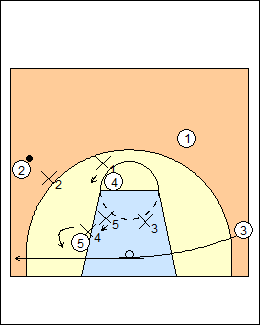 | 16 If 3 runs the baseline to create an overload, X5 helps on the low post so that X4 can get out to the corner, X1 covers the high post. Since X1 covers the high post, the filled corner has priority for X5. If weakside with X2 on the ball, X5 would come across as 3 runs the baseline (see Low post corner filled). Oliver - X4 goes out on a pass to 3, X5 comes down to cover 5, X1 can cover the high post. Variation - X1 bumps X2 down to 3, X5 stays with 4, see Tubby Smith 2-3. See 1-2-2 match-up situations - Three deep, Two-guard runner.  |
This page was made with Basketball playbook from Jes-Soft